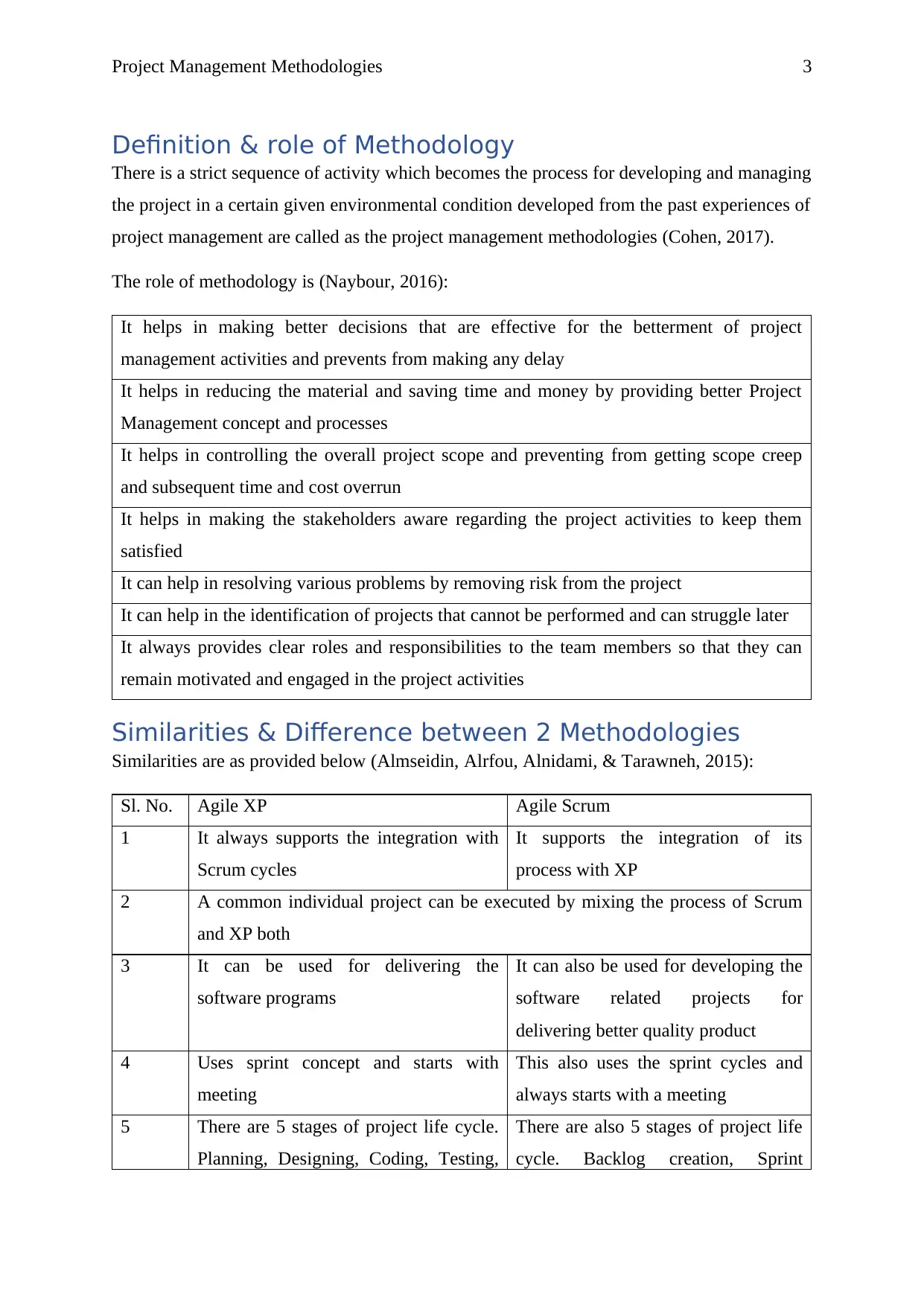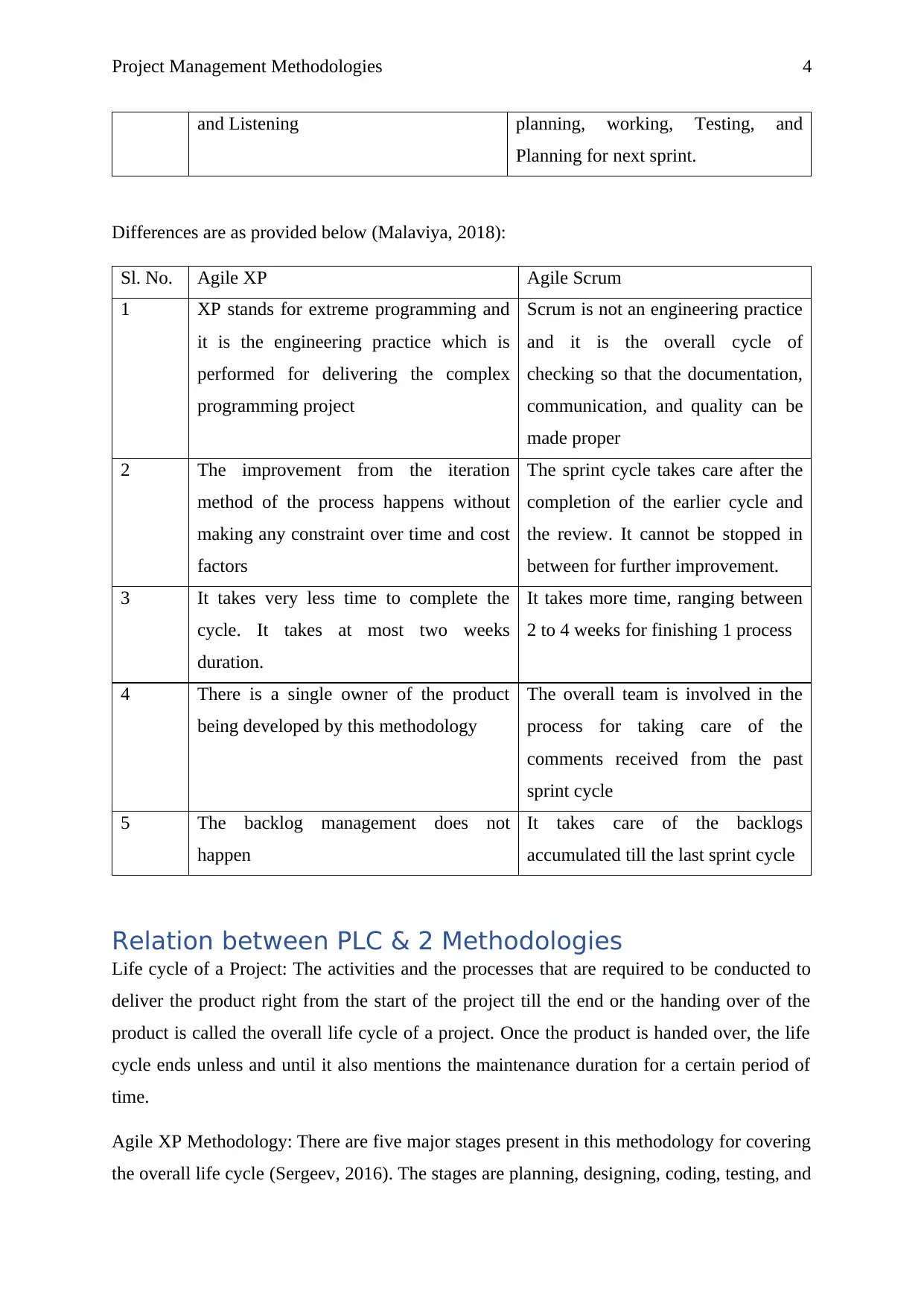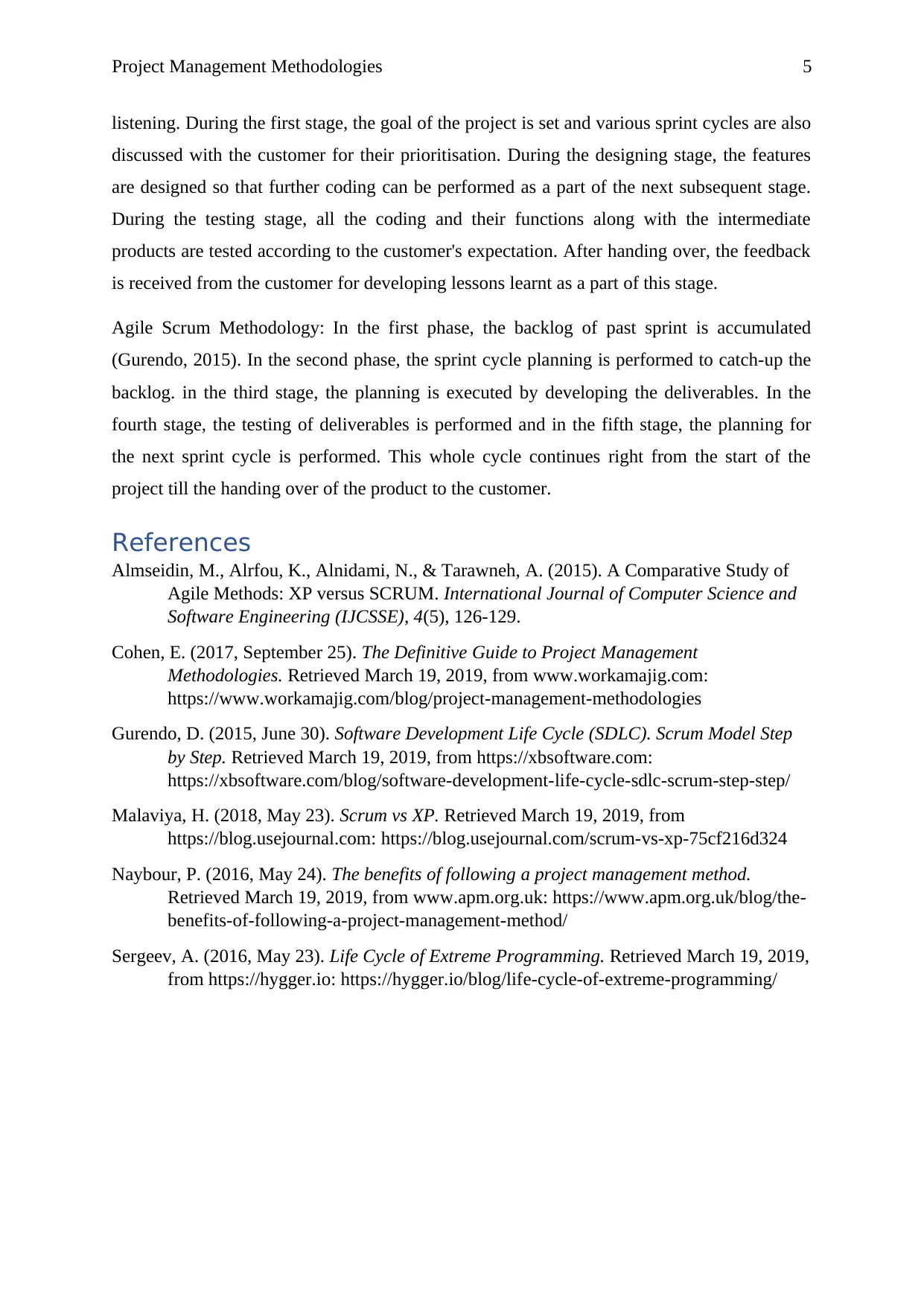ICT 505: Project Management Methodologies Analysis and Comparison
VerifiedAdded on 2023/04/10
|5
|960
|331
Report
AI Summary
This report provides a comprehensive analysis of project management methodologies, focusing on Agile XP and Scrum. It begins by defining project management methodologies and their role in IT projects. The report then delves into the similarities and differences between Agile XP and Scrum, highlighting their respective strengths and weaknesses. Furthermore, it explores the relationship between these methodologies and the project life cycle (PLC), outlining the stages involved in each approach. The report draws on various sources to support its findings, offering valuable insights into the practical application of these methodologies in real-world project scenarios. The content is part of an ICT 505 assignment, demonstrating a clear understanding of project management principles and practices.

ICT 505
Name of University
ID & Name of Student
Date:
Name of University
ID & Name of Student
Date:
Paraphrase This Document
Need a fresh take? Get an instant paraphrase of this document with our AI Paraphraser

Project Management Methodologies 2
Table of Contents
Definition & role of Methodology.............................................................................................3
Similarities & Difference between 2 Methodologies.................................................................3
Relation between PLC & 2 Methodologies...............................................................................4
References..................................................................................................................................5
Table of Contents
Definition & role of Methodology.............................................................................................3
Similarities & Difference between 2 Methodologies.................................................................3
Relation between PLC & 2 Methodologies...............................................................................4
References..................................................................................................................................5

Project Management Methodologies 3
Definition & role of Methodology
There is a strict sequence of activity which becomes the process for developing and managing
the project in a certain given environmental condition developed from the past experiences of
project management are called as the project management methodologies (Cohen, 2017).
The role of methodology is (Naybour, 2016):
It helps in making better decisions that are effective for the betterment of project
management activities and prevents from making any delay
It helps in reducing the material and saving time and money by providing better Project
Management concept and processes
It helps in controlling the overall project scope and preventing from getting scope creep
and subsequent time and cost overrun
It helps in making the stakeholders aware regarding the project activities to keep them
satisfied
It can help in resolving various problems by removing risk from the project
It can help in the identification of projects that cannot be performed and can struggle later
It always provides clear roles and responsibilities to the team members so that they can
remain motivated and engaged in the project activities
Similarities & Difference between 2 Methodologies
Similarities are as provided below (Almseidin, Alrfou, Alnidami, & Tarawneh, 2015):
Sl. No. Agile XP Agile Scrum
1 It always supports the integration with
Scrum cycles
It supports the integration of its
process with XP
2 A common individual project can be executed by mixing the process of Scrum
and XP both
3 It can be used for delivering the
software programs
It can also be used for developing the
software related projects for
delivering better quality product
4 Uses sprint concept and starts with
meeting
This also uses the sprint cycles and
always starts with a meeting
5 There are 5 stages of project life cycle.
Planning, Designing, Coding, Testing,
There are also 5 stages of project life
cycle. Backlog creation, Sprint
Definition & role of Methodology
There is a strict sequence of activity which becomes the process for developing and managing
the project in a certain given environmental condition developed from the past experiences of
project management are called as the project management methodologies (Cohen, 2017).
The role of methodology is (Naybour, 2016):
It helps in making better decisions that are effective for the betterment of project
management activities and prevents from making any delay
It helps in reducing the material and saving time and money by providing better Project
Management concept and processes
It helps in controlling the overall project scope and preventing from getting scope creep
and subsequent time and cost overrun
It helps in making the stakeholders aware regarding the project activities to keep them
satisfied
It can help in resolving various problems by removing risk from the project
It can help in the identification of projects that cannot be performed and can struggle later
It always provides clear roles and responsibilities to the team members so that they can
remain motivated and engaged in the project activities
Similarities & Difference between 2 Methodologies
Similarities are as provided below (Almseidin, Alrfou, Alnidami, & Tarawneh, 2015):
Sl. No. Agile XP Agile Scrum
1 It always supports the integration with
Scrum cycles
It supports the integration of its
process with XP
2 A common individual project can be executed by mixing the process of Scrum
and XP both
3 It can be used for delivering the
software programs
It can also be used for developing the
software related projects for
delivering better quality product
4 Uses sprint concept and starts with
meeting
This also uses the sprint cycles and
always starts with a meeting
5 There are 5 stages of project life cycle.
Planning, Designing, Coding, Testing,
There are also 5 stages of project life
cycle. Backlog creation, Sprint
⊘ This is a preview!⊘
Do you want full access?
Subscribe today to unlock all pages.

Trusted by 1+ million students worldwide

Project Management Methodologies 4
and Listening planning, working, Testing, and
Planning for next sprint.
Differences are as provided below (Malaviya, 2018):
Sl. No. Agile XP Agile Scrum
1 XP stands for extreme programming and
it is the engineering practice which is
performed for delivering the complex
programming project
Scrum is not an engineering practice
and it is the overall cycle of
checking so that the documentation,
communication, and quality can be
made proper
2 The improvement from the iteration
method of the process happens without
making any constraint over time and cost
factors
The sprint cycle takes care after the
completion of the earlier cycle and
the review. It cannot be stopped in
between for further improvement.
3 It takes very less time to complete the
cycle. It takes at most two weeks
duration.
It takes more time, ranging between
2 to 4 weeks for finishing 1 process
4 There is a single owner of the product
being developed by this methodology
The overall team is involved in the
process for taking care of the
comments received from the past
sprint cycle
5 The backlog management does not
happen
It takes care of the backlogs
accumulated till the last sprint cycle
Relation between PLC & 2 Methodologies
Life cycle of a Project: The activities and the processes that are required to be conducted to
deliver the product right from the start of the project till the end or the handing over of the
product is called the overall life cycle of a project. Once the product is handed over, the life
cycle ends unless and until it also mentions the maintenance duration for a certain period of
time.
Agile XP Methodology: There are five major stages present in this methodology for covering
the overall life cycle (Sergeev, 2016). The stages are planning, designing, coding, testing, and
and Listening planning, working, Testing, and
Planning for next sprint.
Differences are as provided below (Malaviya, 2018):
Sl. No. Agile XP Agile Scrum
1 XP stands for extreme programming and
it is the engineering practice which is
performed for delivering the complex
programming project
Scrum is not an engineering practice
and it is the overall cycle of
checking so that the documentation,
communication, and quality can be
made proper
2 The improvement from the iteration
method of the process happens without
making any constraint over time and cost
factors
The sprint cycle takes care after the
completion of the earlier cycle and
the review. It cannot be stopped in
between for further improvement.
3 It takes very less time to complete the
cycle. It takes at most two weeks
duration.
It takes more time, ranging between
2 to 4 weeks for finishing 1 process
4 There is a single owner of the product
being developed by this methodology
The overall team is involved in the
process for taking care of the
comments received from the past
sprint cycle
5 The backlog management does not
happen
It takes care of the backlogs
accumulated till the last sprint cycle
Relation between PLC & 2 Methodologies
Life cycle of a Project: The activities and the processes that are required to be conducted to
deliver the product right from the start of the project till the end or the handing over of the
product is called the overall life cycle of a project. Once the product is handed over, the life
cycle ends unless and until it also mentions the maintenance duration for a certain period of
time.
Agile XP Methodology: There are five major stages present in this methodology for covering
the overall life cycle (Sergeev, 2016). The stages are planning, designing, coding, testing, and
Paraphrase This Document
Need a fresh take? Get an instant paraphrase of this document with our AI Paraphraser

Project Management Methodologies 5
listening. During the first stage, the goal of the project is set and various sprint cycles are also
discussed with the customer for their prioritisation. During the designing stage, the features
are designed so that further coding can be performed as a part of the next subsequent stage.
During the testing stage, all the coding and their functions along with the intermediate
products are tested according to the customer's expectation. After handing over, the feedback
is received from the customer for developing lessons learnt as a part of this stage.
Agile Scrum Methodology: In the first phase, the backlog of past sprint is accumulated
(Gurendo, 2015). In the second phase, the sprint cycle planning is performed to catch-up the
backlog. in the third stage, the planning is executed by developing the deliverables. In the
fourth stage, the testing of deliverables is performed and in the fifth stage, the planning for
the next sprint cycle is performed. This whole cycle continues right from the start of the
project till the handing over of the product to the customer.
References
Almseidin, M., Alrfou, K., Alnidami, N., & Tarawneh, A. (2015). A Comparative Study of
Agile Methods: XP versus SCRUM. International Journal of Computer Science and
Software Engineering (IJCSSE), 4(5), 126-129.
Cohen, E. (2017, September 25). The Definitive Guide to Project Management
Methodologies. Retrieved March 19, 2019, from www.workamajig.com:
https://www.workamajig.com/blog/project-management-methodologies
Gurendo, D. (2015, June 30). Software Development Life Cycle (SDLC). Scrum Model Step
by Step. Retrieved March 19, 2019, from https://xbsoftware.com:
https://xbsoftware.com/blog/software-development-life-cycle-sdlc-scrum-step-step/
Malaviya, H. (2018, May 23). Scrum vs XP. Retrieved March 19, 2019, from
https://blog.usejournal.com: https://blog.usejournal.com/scrum-vs-xp-75cf216d324
Naybour, P. (2016, May 24). The benefits of following a project management method.
Retrieved March 19, 2019, from www.apm.org.uk: https://www.apm.org.uk/blog/the-
benefits-of-following-a-project-management-method/
Sergeev, A. (2016, May 23). Life Cycle of Extreme Programming. Retrieved March 19, 2019,
from https://hygger.io: https://hygger.io/blog/life-cycle-of-extreme-programming/
listening. During the first stage, the goal of the project is set and various sprint cycles are also
discussed with the customer for their prioritisation. During the designing stage, the features
are designed so that further coding can be performed as a part of the next subsequent stage.
During the testing stage, all the coding and their functions along with the intermediate
products are tested according to the customer's expectation. After handing over, the feedback
is received from the customer for developing lessons learnt as a part of this stage.
Agile Scrum Methodology: In the first phase, the backlog of past sprint is accumulated
(Gurendo, 2015). In the second phase, the sprint cycle planning is performed to catch-up the
backlog. in the third stage, the planning is executed by developing the deliverables. In the
fourth stage, the testing of deliverables is performed and in the fifth stage, the planning for
the next sprint cycle is performed. This whole cycle continues right from the start of the
project till the handing over of the product to the customer.
References
Almseidin, M., Alrfou, K., Alnidami, N., & Tarawneh, A. (2015). A Comparative Study of
Agile Methods: XP versus SCRUM. International Journal of Computer Science and
Software Engineering (IJCSSE), 4(5), 126-129.
Cohen, E. (2017, September 25). The Definitive Guide to Project Management
Methodologies. Retrieved March 19, 2019, from www.workamajig.com:
https://www.workamajig.com/blog/project-management-methodologies
Gurendo, D. (2015, June 30). Software Development Life Cycle (SDLC). Scrum Model Step
by Step. Retrieved March 19, 2019, from https://xbsoftware.com:
https://xbsoftware.com/blog/software-development-life-cycle-sdlc-scrum-step-step/
Malaviya, H. (2018, May 23). Scrum vs XP. Retrieved March 19, 2019, from
https://blog.usejournal.com: https://blog.usejournal.com/scrum-vs-xp-75cf216d324
Naybour, P. (2016, May 24). The benefits of following a project management method.
Retrieved March 19, 2019, from www.apm.org.uk: https://www.apm.org.uk/blog/the-
benefits-of-following-a-project-management-method/
Sergeev, A. (2016, May 23). Life Cycle of Extreme Programming. Retrieved March 19, 2019,
from https://hygger.io: https://hygger.io/blog/life-cycle-of-extreme-programming/
1 out of 5
Related Documents
Your All-in-One AI-Powered Toolkit for Academic Success.
+13062052269
info@desklib.com
Available 24*7 on WhatsApp / Email
![[object Object]](/_next/static/media/star-bottom.7253800d.svg)
Unlock your academic potential
Copyright © 2020–2025 A2Z Services. All Rights Reserved. Developed and managed by ZUCOL.





